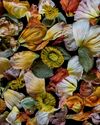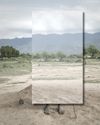
This series represents a silent story told, a statement, a performance. To lessen misunderstandings in this sensitive subject, let's invoke the book of words, for, beyond words' immediate denotations, they have connotative powers.
The Process:
Performance (Oxford Dictionary Online):
1. 'An act of presenting a play, concert, or other forms of entertainment; performances are with physical movements but also with spoken words, sounds, noise, this in stark contrast with the contemplative silence of a photograph. Interesting to visualize this tension.
Silenced:
In general, we women are educated, we learn not to speak our minds ODO 2.1 'A task or operation seen in terms of how successfully it is performed.' But, if we do speak our minds, it is often classified as ODO 1.2' A display of exaggerated behavior or a process involving a great deal of unnecessary time and effort; a fuss.'
Silenced twice:
For people with vaginas, orgasms commonly come from the clitoris. Female Genital Mutilation: the most severe — infibulation — is the removal of the clitoris and parts of the external genitalia followed by stitching together of what remains.
Words are like pearls, rolling formed, developed and cultivated over time, treasured, colorful, shiny, lustrous pearls of wisdom.
This story is from the June 2021 edition of Lens Magazine.
Start your 7-day Magzter GOLD free trial to access thousands of curated premium stories, and 8,500+ magazines and newspapers.
Already a subscriber ? Sign In
This story is from the June 2021 edition of Lens Magazine.
Start your 7-day Magzter GOLD free trial to access thousands of curated premium stories, and 8,500+ magazines and newspapers.
Already a subscriber? Sign In

IN THE SHIPYARDS OF DHAKA
A very large shipyard in Dhaka is located on the Buriganga River's banks, directly across Dhaka's old city.

Aga Szydlik INDIA
A JOURNEY INTO THE LAND OF DIVERSITY, CULTURE, AND COLORS

SEBASTIAN PIÓREK EXPLORING Enjoyable LANDSCAPE
I retrieved the idea of nature closely linked to the field of human feelings.

JEAN KAROTKIN GYMNOPEDIES
Gymnopédies, Karotkin's ongoing series of botanical portraits, takes its name from a trio of piano compositions by 19th-century French composer Erik Satie.

BUTTERFLIES IN LOVE WITH FLOWERS
I sometimes think Chinese art is not fully appreciated in the West. I was exposed to it growing up in Australia, although my fascination was more with calligraphy.

Lissa Hahn:
Hahn: HOW TO EVOKE A PAVLOVIAN RESPONSE IN HUMANS

The Art of DISAPPEARING
In the classical proposal, indigenous people are usually the topic of discussion, but rarely do they have a hand in shaping it.

AGING SINGAPORE
A PHOTOGRAPHY EXHIBITION

An Exclusive Interview With Brice Gelot
"Nothing's more interesting than reality. So from rough areas that never see tourists to poor neighborhoods where I can find chaos, I find beauty. I let the street speak, and I just document what I see...”

Mark Edward Harris: Wabi-sabi and the Japanese Aesthetic
"From the 6th century until the introduction of the Gregorian calendar in 1873, Japan used a variation of the lunisolar Chinese calendar that was divided into 24 seasons. These mini-seasons were determined by the phases of the moon, the rise of the tides, and other natural phenomena. Living in constant contact with their surroundings - the mountains, the ocean, and their all-important rice fields - people were acutely aware of even the smallest changes in their environment and often celebrated them with "matsuri" (festivals).